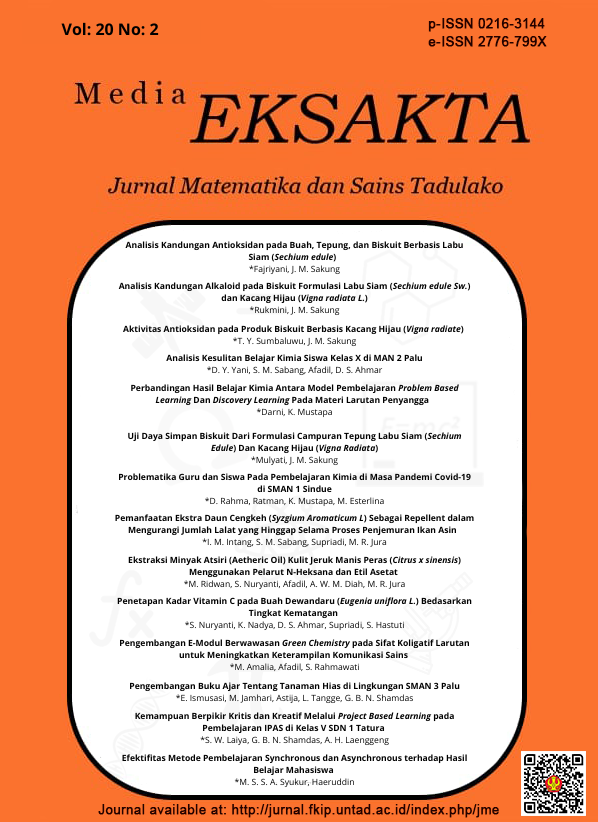Antioxidant Activity in Mung Bean Based Biscuits (Vigna radiate)
DOI:
https://doi.org/10.22487/me.v20i2.2411Keywords:
Antioxidants, mung bean, mung bean flour, mung bean biscuitAbstract
Mung bean (Vigna radiate) is one of the legumes that has many benefits for the body. This study aims to determine the antioxidant activity of biscuit flour from mung bean (Vigna radiate) using UV-Vis spectrophotometry. The research method was carried out experimentally including : analyzing the antioxidant content of green beans, flour, and mung bean biscuits. Antioxidant activity testing in this study was using DPPH reagent (2,2-diphenyl-1-picrylhydrazil) as a source of free radicals. Based on the results of the study, the extracts of mung bean, flour and biscuit were analyzed for their antioxidant activity with various concentrations of 20 ppm, 40 ppm, 60 ppm, 80 ppm, 100 ppm. The results showed that raw mung bean seed extract had weak antioxidant power with an average IC50 value of 275,103 ppm, mung bean flour was 172, 102 ppm and mung bean biscuit was 186, 664 ppm.
References
N. B. Nugraha, Corporate Social Effects Responsibility, Company Size, Profitability, Leverage and Capital Intensity To Tax Agresivity. In Diponegoro Journal of Accounting (vol. 4). (2015).
M. R. Runtuwene and D. Wewengkang, “Uji Aktivitas Antioksidan dan Toksisitas Ekstrak Etanol Daun Foki Sabarati (Solanum Torvum),” Pharmacon, vol. 5, no. 3, pp. 94–101, 2016, [Online]. Available: https://doi.org/10.35799/pha.5.2016.12942
P. S. Widyawati, T. D. W. Budianta, Y. D. W. Werdani, and M. O. Halim, “Aktivitas Antioksidan Minuman Daun Beluntas Teh Hitam (Pluchea indica Less-Camelia sinensis),” Agritech, vol. 38, no. 2, p. 200, 2018, doi: 10.22146/agritech.25699.
A. . Richard, “ Uji Aktivitas Antioksidan dengan Metode DPPH Ekstrak Bromelain Buah Nanas,” 2016.
C. G. Fraga, K. D. Croft, D. O. Kennedy, and F. A. Tomás-Barberán, “The Effects of Polyphenols and Other Bioactives on Human Health” Food Funct., vol. 10, no. 2, pp. 514–528, 2019, doi: 10.1039/c8fo01997e.
j S. Zebua, “Kualitas Benih Kacang Hijau (Vigna radiata (L.) R. Wilczek) pada Pertanaman Monokultur dan Tumpangsari dengan Jagung (Zea mays L.).,” 2012.
S. Fathonah, “Teknologi Penepungan Kacang Hijau dan Terapannya pada Biskuit,” J. Kompetensi Tek., vol. 10, no. 1, pp. 12–21, 2018.
D. H. K. Wardani, “Pengaruh Substitusi Tepung Kacang Hijau (Vigna radiata L.) terhadap Kadar Protein dan Daya Terima Bolu Kukus,” Univ. Muhammadiyah Surakarta, vol. 2, no. 2, p. 12, 2018.
K. Kurniawati and F. Ayustaningwarno, “Pengaruh Substitusi Tepung Terigu dengan Tepung Tempe dan Tepung Ubi Jalar Kuning Terhadap Kadar Protein, Kadar Β-Karoten, Dan Mutu Organoleptik Roti Manis,” J. Nutr. Coll., vol. 1, no. 1, pp. 344–351, 2012, doi: 10.14710/jnc.v1i1.511.
A. and A. Isnaeni, P. Ana, Iriantom, “Poltekkes Kemenkes Yogyakarta | 9,” J. Kesehat., vol. 6, no. 6, pp. 9–33, 2012, [Online]. Available: http://eprints.poltekkesjogja.ac.id/1134/4/4. Chapter 2.pdf
M. E. Papunas, G. S. S. Djarkasi, and J. C. Moningka, “… Dan Sensoris Flakes Berbahan Baku Tepung Jagung (Zea mays L), Tepung Pisang Goroho (Musa acuminafe, sp) dan Tepung Kacang Hijau (Phaseolus …,” Cocos, 2013, [Online]. Available: https://ejournal.unsrat.ac.id/index.php/cocos/article/download/2494/2030
S. Yanti and D. Suksmayu Saputri, “UJI AKTIVITAS ANTIOKSIDAN SERBUK EKSTRAK BELIMBING WULUH (Averrhoa blimbi L.),” J. TAMBORA, vol. 3, no. 2, pp. 16–26, 2019, doi: 10.36761/jt.v3i2.252.
W. H, “Antioksidan alami & radikal bebas,” 2007.
K. Maesaroh, D. Kurnia, and J. Al Anshori, “Perbandingan Metode Uji Aktivitas Antioksidan DPPH, FRAP dan FIC Terhadap Asam Askorbat, Asam Galat dan Kuersetin,” Chim. Nat. Acta, vol. 6, no. 2, p. 93, 2018, doi: 10.24198/cna.v6.n2.19049.
W. Widyaningsih, “Uji Aktivitas Antioksidan Ekstrak Etanol Daun Dewa (Gynura Procumbens) dengan Metode DPPH (1,1-difenil-2-pikrilhidrazil),” Pros. Semin. Nas. Kosmet. Alami , pp. 109–115, 2010.
Downloads
Published
How to Cite
License
Copyright (c) 2024 Theresia Yutzahari Sumbaluwu, Jamaluddin M Sakung

This work is licensed under a Creative Commons Attribution-ShareAlike 4.0 International License.
Authors who publish with Jurnal Media Eksakta agree to the following terms:
- Authors retain copyright and grant the journal right of first publication with the work simultaneously licensed under a Creative Commons Attribution License (CC BY-SA 4.0) that allows others to share the work with an acknowledgment of the work's authorship and initial publication in this journal.
- Authors are able to enter into separate, additional contractual arrangements for the non-exclusive distribution of the journal's published version of the work (e.g., post it to an institutional repository or publish it in a book), with an acknowledgment of its initial publication in this journal.
- Authors are permitted and encouraged to post their work online (e.g., in institutional repositories or on their website) prior to and during the submission process, as it can lead to productive exchanges, as well as earlier and greater citation of published work.




